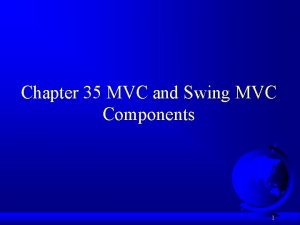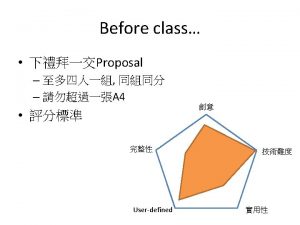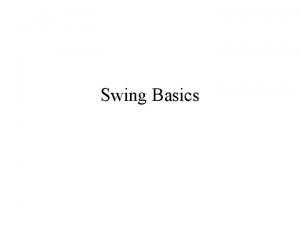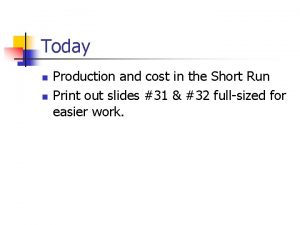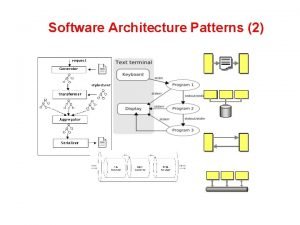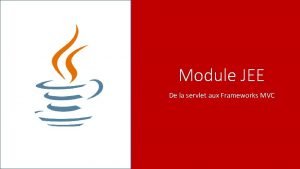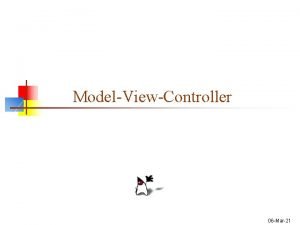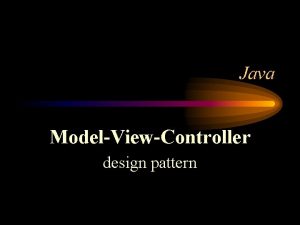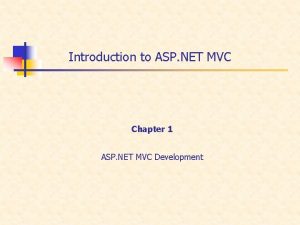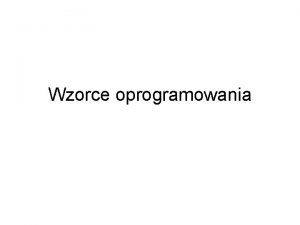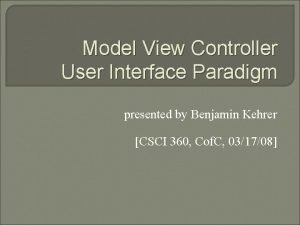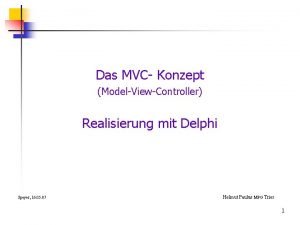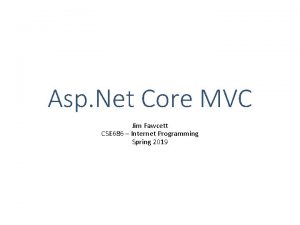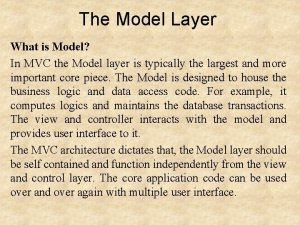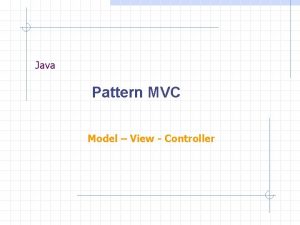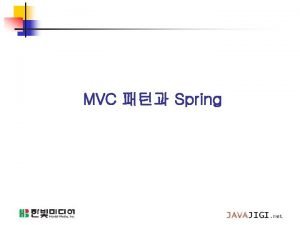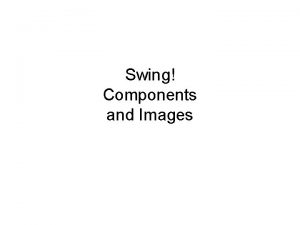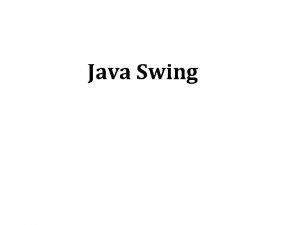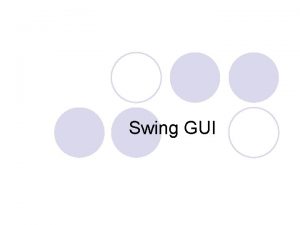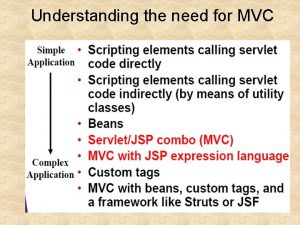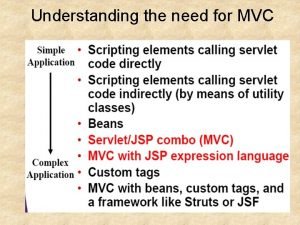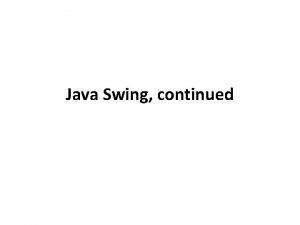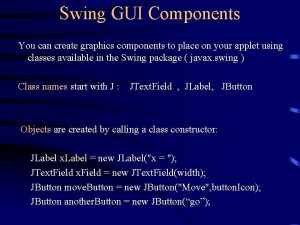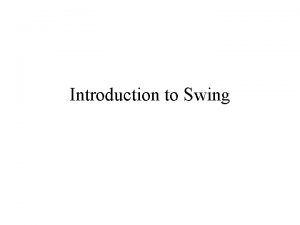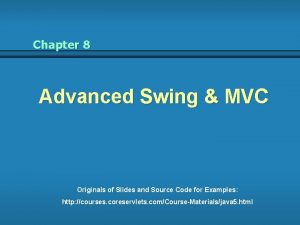Chapter 39 MVC and Swing MVC Components 1


































- Slides: 34

Chapter 39 MVC and Swing MVC Components 1

Objectives F F F F F To use the model-view-controller approach to separate data and logic from the presentation of data (§ 39. 2). To implement the model-view-controller components using the Java. Beans event model (§ 39. 2). To explain the Swing model-view-controller architecture (§ 39. 4). To use JSpinner to scroll the next and previous values (§ 39. 5). To create custom spinner models and editors (§ 39. 6). To use JList to select single or multiple items in a list (§ 39. 7). To add and remove items using List. Model and Default. List. Model (§ 39. 8). To render list cells using a default or custom cell renderer (§ 39. 9). To create custom combo box models and renderers (§ 39. 10). 2

Model-View-Controller (MVC) The model-view-controller (MVC) approach is a way of developing components by separating data storage and handling from the visual representation of the data. The component for storing and handling data, known as a model, contains the actual contents of the component. The component for presenting the data, known as a view, handles all essential component behaviors. It is the view that comes to mind when you think of the component. It does all the displaying of the components. The controller is a component that is usually responsible for obtaining data. 3

Benefits of MVC It makes multiple views possible so that data can be shared through the same model. For example, a model storing student names can simultaneously be displayed in a combo box or in a list box It simplifies the task of writing complex applications and makes the components scalable and easy to maintain. Changes can be made to the view without affecting the model, and vice versa 4

Synchronization between Model and View A model contains data, whereas a view makes the data visible. Once a view is associated with a model, it immediately displays updates to the model. This ensures that all the views of the model display the same data consistently. To achieve consistency and synchronize the model with its dependent views, the model should notify the views when there is a change in a property in the model that is used in the view. In response to a change notification, the view is responsible for redisplaying the viewing area affected by the property change. The JDK event delegation model provides a superior architecture for supporting MVC component development. The model can be implemented as a source with appropriate event and event listener registration methods. The view can be implemented as a listener. Thus, if data are changed in the model, the view will be notified. To enable the selection of the model from the view, simply add the model as a property in the view with a set method. 5

Example: Developing Model-View-Controller Components Problem: The example creates a model named Circle. Model, a view named Circle. View and a controller named Circle. Control. Circle. Model stores the properties (radius, filled, and color) that describe a circle. filled is a boolean value that indicates whether a circle is filled. Circle. View draws a circle according to the properties of the circle. Control enables the user to enter circle properties from a graphical user interface. Create an applet with two buttons named Show Controller and Show View. When click the Show Controller button, the controller is displayed in a frame. When click the Show View button, the view is displayed in a separate frame. controller view 6

Circle. Model The circle model stores the data and notifies any change of data to the listeners. The circle model contains properties radius, filled, and color, as well as the registration/deregistration methods for action event. Circle. Model 7

Circle. View The view implements Action. Listener to listen for notifications from the model. It contains the model as its property. When a model is set in the view, the view is registered with the model. The view extends JPanel to override the paint. Component method to draw the circle according to the properties values specified in the model. Circle. View 8

Circle. Controller The controller presents a GUI interface that enables the user to enter circle properties radius, filled, and color. It contains the model as its property. You can use the set. Model method to associate a circle model with the controller. It uses a text field to obtain a new radius and a combo box to obtain a boolean value to specify whether the circle is filled. Circle. Controller 9

Putting Things Together Finally, let us create an applet named MVCDemo with two buttons Show Controller and Show View. The Show Controller button displays a controller in a frame and the Show View button displays a view in a separate frame. MVCDemo Run 10

MVC Variations One variation of the model-view-controller architecture is to combine the controller with the view. In this case, a view not only presents the data, but is also used as an interface to interact with the user and accept user input. Another variation of the model-view-controller architecture is to add part of the data from the model to the view so that the frequently used data can be accessed directly from the view. 11

Swing MVC NOTE: Swing components are designed using the MVC architecture. Each Swing GUI component is a view that uses a model to store data. Many components contain part of the data in the model so that they can be accessed directly from the component. 12

Swing Model-View-Controller Architecture Each Swing user interface component (except some containers and dialog boxes such as JPanel, JSplit. Pane, JFile. Chooser, and JColor. Chooser) has a property named model that refers to its data model. The data model is defined in an interface whose name ends with Model. For example, the model for button component is Button. Model. Most model interfaces have a default implementation class that is commonly named Default. X, where X is its model interface name. For example, the default implementation class for Button. Model is Default. Button. Model. 13

Swing Components and Their Models For convenience, most Swing components contain some properties of their models, and these properties can be accessed and modified directly from the component without knowing the existence of the model. For example, the properties action. Command mnemonic are defined in both Button. Model and JButton. Actually, these properties are in the Abstract. Button class. Since JButton is a subclass of Abstract. Button, JButton inherits all the properties from Abstract. Button. It is unnecessary to use the models for the simple Swing components such as JButton, JToggle. Button, JCheck. Box, JRadio. Button, JText. Field, and JText. Area, because the frequently used properties in their models are also in these components. You can access and modify these properties directly through the components. For advanced components such as JSpinner, JList, JCombo. Box, JTable, and JTree, you have to work with their models to store, access and modify data. 14

JSpinner A spinner is a text field with a pair of tiny arrow buttons on its right side that enable the user to select numbers, dates, or values from an ordered sequence. The keyboard up/down arrow keys also cycle through the elements. The user may also be allowed to type a (legal) value directly into the spinner. A spinner is similar to a combo box, but a spinner is sometimes preferred because it doesn't require a drop down list that can obscure important data. 15

The JSpinner Class A JSpinner's sequence value is defined by the Spinner. Model interface, which manages a potentially unbounded sequence of elements. The model doesn't support indexed random access to sequence elements. Only three sequence elements are accessible at a time: current, next and previous using the methods get. Value(), get. Next. Value(), and get. Previous. Value(), respectively. 16

Example: A Simple JSpinner Demo Problem: This example creates a JSpinner object for a sequence of numbers and displays the previous, current, and next number from the spinner on a label. NOTE: If you create a JSpinner object without specifying a model, the spinner displays a sequence of integers. Simple. Spinner Run 17

Spinner Models Spinner. Model is an interface for all spinner models. Abstract. Spinner. Model is a convenience abstract class that implements Spinner. Model and provides the implementation for the registration/deregistration methods. Spinner. List. Model, Spinner. Number. Model, and Spinner. Date. Model are concrete implementations of Spinner. Model. 18

Spinner. List. Model is a simplementation of Spinner. Model whose values are stored in a java. util. List. 19

Spinner. Number. Model is a concrete implementation of Spinner. Model that represents a sequence of numbers. It contains the properties maximum, minimum, and step. Size. 20

Spinner. Date. Model is a concrete implementation of Spinner. Model that represents a sequence of dates. The upper and lower bounds of the sequence are defined by properties called start and end and the size of the increase or decrease computed by the next. Value and previous. Value methods is defined by a property called calendar. Field. 21

Example: Using Spinner Models and Editors Problem: This example uses a JSpinner component to display date and three separate JSpinner components to display day in a sequence of numbers, month in a sequence of strings, and year in a sequence of numbers. All these four components are synchronized. For example, if you change year in the spinner for year, the date value in the date spinner is updated accordingly. Spinner. Model. Editor. Demo Run 22

JList has two supporting models: a list model and a list-selection model. The list model is for storing and processing data. The list-selection model is for selecting items. By default, items are rendered as strings or icons. You can also create a custom renderer implementing the List. Cell. Renderer interface. 23

The JList Class 24

The layout. Orientation property JList jlst = new JList(); jlst. set. Layout. Orientation(int); 25

The selection. Mode property JList jlst = new JList(); jlst. set. Selection. Mode(int); JList. SINGLE_SELECTION JList. SINGLE_INTERVAL_SELECTION JList. MULTIPLE_INTERVAL_SELECTION 26

Example: List Properties Demo Problem: This example creates a list of a fixed number of items displayed as strings. The example enables you to dynamically set visible. Row. Count from a spinner, layout. Orientation from a combo box, and selection. Mode from a combo box. When you select one or more items, their values are displayed in a status label below the list. List. Properties. Demo Run 27

List Models The JList class delegates the responsibilities of storing and maintaining data to its data model. The JList class itself does not have methods for adding or removing items from the list. These methods are supported in List. Model. Abstract. List. Model implements the registration methods in the List. Model, but does not implement the get. Size and get. Element. At methods. Default. List. Model extends Abstract. List. Model and implements the two methods get. Size and get. Element. At, which are not implemented by Abstract. List. Model. 28

Example: List Model Demo Problem: This example creates a list using a list model and allows the user to add and delete items in the list. When the user clicks the Add new item button, an input dialog box is displayed to receive a new item. List. Model. Demo Run 29

List Cell Renderer In addition to delegating data storage and processing to list models, JList delegates the rendering of the list cells to list cell renderers. All list cell renderers implement the List. Cell. Renderer interface, which defines a single method, get. List. Cell. Renderer. Component, as follows By default, JList uses Default. List. Cell. Renderer to render its cells. The Default. List. Cell. Renderer class implements List. Cell. Renderer, extends JLabel, and can display either a string or an icon, but not both in the same cell. You can create a custom renderer by implementing List. Cell. Renderer. 30

Example: List Cell Renderer Demo Problem: This example creates a list of countries and displays the country flags and country names in the list. When a country is selected in the list, its flag is displayed in a panel next to the list. My. List. Cell. Renderer. Demo Run 31

JCombo. Box 32

Combo Box Model JCombo. Box delegates the responsibilities of storing and maintaining data to its data model. All combo box models implement the Combo. Box. Model interface, which extends the List. Model interface and defines the get. Selected. Item and set. Selected. Item methods for retrieving and setting a selected item. The methods for adding and removing items are defined in the Mutable. Combo. Box. Model interface Default. Combo. Box. Model provides a concrete implementation for Combo. Model. 33

Example: Combo Box Cell Renderer Demo Problem: This example creates a combo box that contains a list of countries and displays the country flags and country names in the list cell. When a country is selected in the list, its flag is displayed in a panel below the combo box. Combo. Box. Cell. Renderer Run 34
 Swing mvc example
Swing mvc example Mvc java swing
Mvc java swing Java swing mvc
Java swing mvc Swing components
Swing components Boxlayout swing
Boxlayout swing Java ui libraries
Java ui libraries Mvc html partial
Mvc html partial Authentication filters in mvc 5
Authentication filters in mvc 5 Tvc avc and mvc
Tvc avc and mvc Barry liked playing board games
Barry liked playing board games Difference between swing and applet
Difference between swing and applet Spring bean lifecycle
Spring bean lifecycle Blackboard mvc
Blackboard mvc Mvc muster
Mvc muster Model view controller
Model view controller Trygve reenskaug mvc
Trygve reenskaug mvc Jee mvc
Jee mvc What mvc stands for
What mvc stands for Design pattern mvc java
Design pattern mvc java Mvc mis
Mvc mis Mvc vs webforms
Mvc vs webforms Mvc architecture in jsp
Mvc architecture in jsp Mvt vs mvc
Mvt vs mvc Wzorzec projektowy mvc
Wzorzec projektowy mvc Mvc paradigm
Mvc paradigm Que es struts
Que es struts Delphi mvc
Delphi mvc Asp.net tutorials point
Asp.net tutorials point Mvc life cycle in c#
Mvc life cycle in c# Model layer in mvc
Model layer in mvc Spring mvc 아이디 찾기
Spring mvc 아이디 찾기 Mvc design pattern java
Mvc design pattern java The mvc will monitor a new driver’s habits for how long?
The mvc will monitor a new driver’s habits for how long? Altering a driver's license
Altering a driver's license Eclipse plugin
Eclipse plugin
